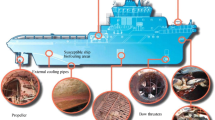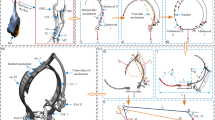Abstract
Intervention autonomous underwater vehicles (I-AUVs) have the potential to open new avenues for the maintenance and monitoring of offshore subsea facilities in a cost-effective way. However, this requires challenging intervention operations to be carried out persistently, thus minimizing human supervision and ensuring a reliable vehicle behaviour under unexpected perturbances and failures. This paper describes a system to perform autonomous intervention—in particular valve-turning—using the concept of persistent autonomy. To achieve this goal, we build a framework that integrates different disciplines, involving mechatronics, localization, control, machine learning and planning techniques, bearing in mind robustness in the implementation of all of them. We present experiments in a water tank, conducted with Girona 500 I-AUV in the context of a multiple intervention mission. Results show how the vehicle sets several valve panel configurations throughout the experiment while handling different errors, either spontaneous or induced. Finally, we report the insights gained from our experience and we discuss the main aspects that must be matured and refined in order to promote the future development of intervention autonomous vehicles that can operate, persistently, in subsea facilities.


























Similar content being viewed by others
References
Ahmadzadeh, S. R., Kormushev, P., Jamisola, R. S., & Caldwell, D. G. (2014). Learning reactive robot behavior for autonomous valve turning. In 2014 IEEE International Conference on Humanoid Robots (Humanoids). Madrid: IEEE.
Bay, H., Ess, A., Tuytelaars, T., & Van Gool, L. (2008). Speeded-up robust features (SURF). Computer Vision and Image Understanding, 110(3), 346–359. doi:10.1016/j.cviu.2007.09.014.
Beetz, M., Jain, D., Mösenlechner, L., Tenorth, M., Kunze, L., Blodow, N., et al. (2012). Cognition-enabled autonomous robot control for the realization of home chore task intelligence. Proceedings of the IEEE, 100(8), 2454–2471.
Benton, J., Coles, A., & Coles, A. (2012). Temporal planning with preferences and time-dependent continuous costs. In Proceedings of the international conference on automated planning and scheduling (ICAPS).
Calinon, S., D’halluin, F., Sauser, E. L., Caldwell, D. G., & Billard, A. (2010). Learning and reproduction of gestures by imitation. IEEE Robotics and Automation Magazine, 17(2), 44–54.
Calonder, M., Lepetit, V., Strecha, C., & Fua, P. (2010). BRIEF: Binary robust independent elementary features. In Proceedings of the 11th European conference on computer vision: Part IV, ECCV’10 (pp. 778–792). Berlin, Heidelberg: Springer-Verlag. http://dl.acm.org/citation.cfm?.id=1888089.1888148.
Camilli, R., Reddy, C. M., Yoerger, D. R., Van Mooy, B. A., Jakuba, M. V., Kinsey, J. C., et al. (2010). Tracking hydrocarbon plume transport and biodegradation at Deepwater Horizon. Science, 330(6001), 201–204.
Caress, D. W., Thomas, H., Kirkwood, W. J., McEwen, R., Henthorn, R., Clague, D. A., Paull, C. K., Paduan, J., & Maier, K. L. (2008). High-resolution multibeam, sidescan, and subbottom surveys using the MBARI AUV D. Allan B. Marine habitat mapping technology for Alaska pp. 47–69.
Cashmore, M., Fox, M., Larkworthy, T., Long, D., & Magazzeni, D. (2013). Planning inspection tasks for AUVs. In Proceedings of the MTS/IEEE oceans 2013 conference, San Diego (OCEANS’13).
Cashmore, M., Fox, M., Larkworthy, T., Long, D., & Magazzeni, D. (2014). AUV mission control via temporal planning. In IEEE international conference on robotics and automation (ICRA’14).
Coles, A., Coles, A., Fox, M., & Long, D. (2010). Forward-chaining partial-order planning. In Proceedings of the 20th international conference on automated planning and scheduling (ICAPS’10) (pp. 42–49).
Englot, B., & Hover, F. (2010). Inspection planning for sensor coverage of 3D marine structures. In IEEE/RSJ international conference on intelligent robots and systems.
Evans, J., Petillot, Y., Redmond, P., Wilson, M., & Lane, D. (2003). AUTOTRACKER: AUV embedded control architecture for autonomous pipeline and cable tracking. In MTS/IEEE oceans (pp. 2651–2658). San Diego, CA.
Fossen, T. (1994). Guidance and control of ocean vehicles. New York: Wiley.
Fossen, T. I. (1994). Guidance and control of ocean vehicles. Chichester, UK: Wiley.
Fossen, T. I. (2011). Handbook of marine craft hydrodynamics and motion control. New York: Wiley.
Fox, M., & Long, D. (2003). PDDL2.1: An extension to PDDL for expressing temporal planning domains. Journal of Artificial Intelligence Researsh (JAIR), 20, 61–124.
Fox, M., Long, D., & Magazzeni, D. (2011). Automatic construction of efficient multiple battery usage policies. In Proceedings of the 21st international conference on automated planning and scheduling (ICAPS).
Fox, M., Long, D., & Magazzeni, D. (2012). Plan-Based policy-learning for autonomous feature tracking. In Proceedings of the 22nd international conference on automated planning and scheduling (ICAPS).
Ghallab, M., Nau, D., & Traverso, P. (2004). Automated planning: Theory and practice. San Francisco, CA: Morgan Kaufmann.
Gracias, N., Bosch, J., & Karim, E. M. (2015). Pose estimation for underwater vehicles using light beacons. In Proceedings of the IFAC workshop on navigation, guidance and control of underwater vehicles, IFAC NGCUV 2015. Spain: Girona.
Gracias, N., Ridao, P., Garcia, R., Escartin, J., L’Hour, M., Cibecchini, F., Campos, R., Carreras, M., Ribas, D., & Palomeras, N., et al. (2013). Mapping the Moon: Using a lightweight AUV to survey the site of the 17th century ship “La Lune”. In OCEANS-Bergen, 2013 MTS/IEEE (pp. 1–8). IEEE.
Hoffmann, H., Pastor, P., Park, D. H., & Schaal, S. (2009). Biologically-inspired dynamical systems for movement generation: Automatic real-time goal adaptation and obstacle avoidance. In ICRA (pp. 2587–2592). IEEE.
Hovland, G., Sikka, P., & McCarragher, B. (1996). Skill acquisition from human demonstration using a hidden Markov model. In Proceedings of the 1996 IEEE international conference on robotics and automation (Vol. 3, pp. 2706–2711). doi:10.1109/ROBOT.1996.506571.
Jones, C. (2012). Slocum glider persistent oceanography. In 2012 IEEE/OES autonomous underwater vehicles (AUV) (pp. 1–6). doi:10.1109/AUV.2012.6380738.
Karras, G. C., Bechlioulis, C. P., Leonetti, M., Palomeras, N., Kormushev, P., Kyriakopoulos, K. J., & Caldwell, D. G. (2013). On-line identification of autonomous underwater vehicles through global derivative-free optimization. In IEEE/RSJ international conference on intelligent robots and systems, 2013. IROS 2013.
Kormushev, P., Calinon, S., & Caldwell, D. G. (2011). Imitation learning of positional and force skills demonstrated via kinesthetic teaching and haptic input. Advanced Robotics, 25(5), 581–603.
Krüger, V., Tikhanoff, V., Natale, L., & Sandini, G. (2012). Imitation learning of non-linear point-to-point robot motions using dirichlet processes. In ICRA (pp. 2029–2034). IEEE.
Kunz, C., Murphy, C., Singh, H., Pontbriand, C., Sohn, R. A., Singh, S., et al. (2009). Toward extraplanetary under-ice exploration: Robotic steps in the Arctic. Journal of Field Robotics, 26(4), 411–429.
Lane, D. (2014). PANDORA website. Retrieved December 15, 2014.
Lowe, D. G. (2004). Distinctive image features from scale-invariant keypoints. International Journal of Computer Vision, 60(2), 91–110. doi:10.1023/B:VISI.0000029664.99615.94.
Marani, G., Choi, S. K., & Yuh, J. (2009). Underwater autonomous manipulation for intervention missions AUVs. Ocean Engineering, 36(1), 15–23.
Matsubara, T., Hyon, S. H., & Morimoto, J. (2011). Learning parametric dynamic movement primitives from multiple demonstrations. Neural Networks, 24(5), 493–500. doi:10.1016/j.neunet.2011.02.004.
Maurelli, F., Krupinski, S., Petillot, Y., & Salvi, J. (2008). A particle filter approach for AUV localization. In MTS/IEEE OCEANS (pp. 1–7).
McGann, C., Py, F., Rajan, K., Thomas, H., Henthorn, R., & McEwen, R. (2007). T-REX a model-based architecture for AUV control. In ICAPS, workshop in planning and plan execution for real-world systems.
McGann, C., Py, F., Rajan, K., Thomas, H., Henthorn, R., & McEwen, R. (2008). A deliberative architecture for AUV control. In IEEE international conference on robotics and automation (ICRA). Pasadena.
Nagappa, S., Palomeras, N., Lee, C. S., Gracias, N., Clark, D. E., & Salvi, J. (2013). Single cluster PHD SLAM: Application to autonomous underwater vehicles using stereo vision. In 2013 MTS/IEEE OCEANS-Bergen (pp. 1–9). IEEE.
Newman, P., & Leonard, J. (2003). Pure range-only sub-sea SLAM. In IEEE international conference on robotics an automation.
Ozog, P., & Eustice, R. M. (2014). Toward long-term, automated ship hull inspection with visual SLAM, explicit surface optimization, and generic graph-sparsification. In Proceedings of the IEEE international conference on robotics and automation, Hong Kong, China (pp. 3832–3839).
Palmer, T., Ribas, D., Ridao, P., & Aggelos, A. (2009). Vision based localization system for AUV docking on subsea intervention panels. In Oceans 2009-Europe (pp. 1–10).
Pastor, P., Hoffmann, H., Asfour, T., & Schaal, S. (2009) Learning and generalization of motor skills by learning from demonstration. In ICRA (pp. 763–768). IEEE.
Piacentini, C., Alimisis, V., Fox, M., & Long, D. (2013). Combining a temporal planner with an external solver for the power balancing problem in an electricity network. In Proceedings of the 23rd international conference on automated planning and scheduling (ICAPS’13).
Rajan, K., McGann, C., Py, F., & Thomas, H. (2007). Robust mission planning using deliberative autonomy for autonomous underwater vehicles. In ICRA workshop on robotics in challenging and hazardous environments (pp. 21–25).
Ribas, D., Palomeras, N., Ridao, P., Carreras, M., & Mallios, A. (2012). Girona 500 AUV, from survey to intervention. IEEE/ASME Transactions on Mechatronics, 17(1), 46–53.
Ribas, D., Ridao, P., & Neira, J. (2010). Underwater SLAM for structured environments using an imaging sonar. In B. Siciliano, O. Khatib, & F. Groen (Eds.), Springer tracts in advanced robotics. New York: Springer.
Rosten, E., & Drummond, T. (2006) Machine learning for high-speed corner detection. In European conference on computer vision (pp. 430–443).
Salvi, J., Petillot, Y., Thomas, S., & Aulinas, J. (2008). Visual SLAM for underwater vehicles using video velocity log and natural landmarks. In: Oceans conference.
Sanz, P. J., Ridao, P., Oliver, B., Casalino, G., Silvestre, C., Melchiorri, C., et al. (2012). TRIDENT: Recent improvements about autonomous underwater intervention missions. In Navigation, guidance and control of underwater vehicles (Vol. 3).
Simmons, R. G., Goodwin, R., Haigh, K. Z., Koenig, S., O’Sullivan, J., & Veloso, M. M. (1997). Xavier: Experience with a layered robot architecture. SIGART Bulletin, 8(1–4), 22–33.
Singh, H., Armstrong, R., Gilbes, F., Eustice, R., Roman, C., Pizarro, O., et al. (2004). Imaging coral I: Imaging coral habitats with the SeaBED AUV. Subsurface Sensing Technologies and Applications, 5(1), 25–42.
Smith, R., Schwager, M., Smith, S. L., Rus, D., & Sukhatme, G. (2011). Persistent ocean monitoring with underwater gliders: Towards accurate reconstruction of dynamic ocean processes. In 2011 IEEE international conference on robotics and automation (ICRA) (pp. 1517–1524). IEEE.
Spooner, J. T., Maggiore, M., Ordonez, R., & Passino, K. M. (2002). Stable adaptive control and estimation for nonlinear systems-neural and fuzzy approximator techniques. New York: Wiley.
SUBSEA7: AIV website. Retrieved December 15, 2014.
Vallicrosa, G., Ridao, P., Ribas, D., & Palomer, A. (2014). Active range-only beacon localization for AUV homing. In 2014 IEEE/RSJ international conference on intelligent robots and systems (IROS 2014) (pp. 2286–2291). IEEE.
Welch, G., & Bishop, G. (1995). An introduction to the Kalman Filter. Technical report, University of North Carolina at Chapel Hill, Chapel Hill, NC.
WillowGarage (2007). Robot operating system. http://www.ros.org Retrieved December, 2014.
Acknowledgments
This work has been supported by the FP7-ICT-2011-7 project PANDORA-Persistent Autonomy through Learning, Adaptation, Observation and Re-planning (Ref. 288273) funded by the European Commission.
Author information
Authors and Affiliations
Corresponding author
Rights and permissions
About this article
Cite this article
Palomeras, N., Carrera, A., Hurtós, N. et al. Toward persistent autonomous intervention in a subsea panel. Auton Robot 40, 1279–1306 (2016). https://doi.org/10.1007/s10514-015-9511-7
Received:
Accepted:
Published:
Issue Date:
DOI: https://doi.org/10.1007/s10514-015-9511-7




